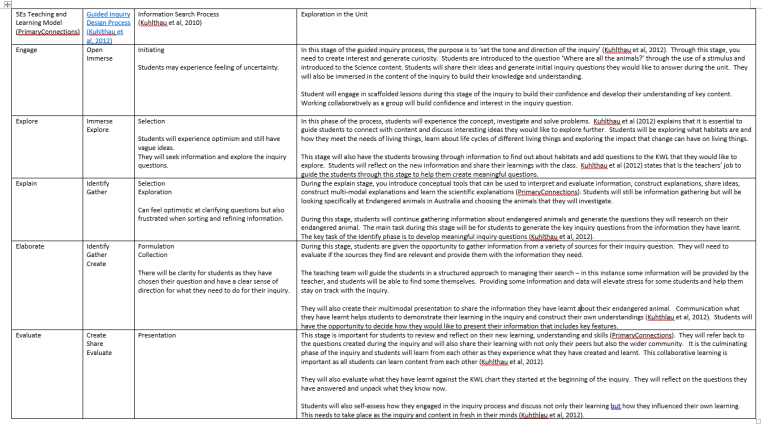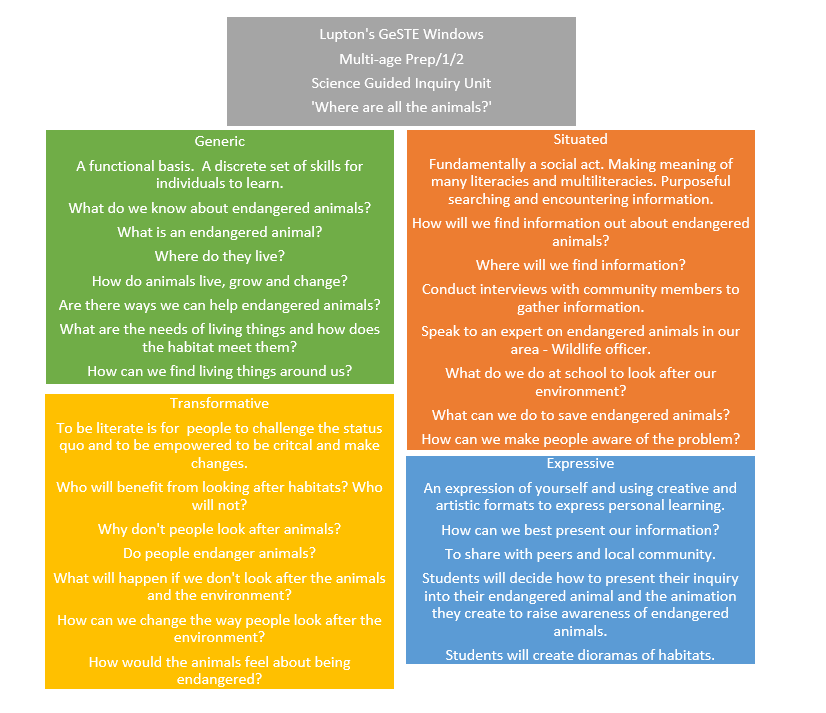Curriculum
This unit is a guided inquiry unit intended for a Prep to Year 2 multi-age classroom. The unit teaches the Australian Curriculum subjects of Science, English and Media Arts using an integrated curriculum approach for year levels Prep, Year 1 and Year 2. As the school context I teach in is a rural, one teacher school, there are no specialist support staff in the school so the unit will be taught by the P – 2 teacher with the support of the teacher aide but will also involve accessing local wildlife officers and local community members. The unit will be taught over a 10-week term (Term 3) and involves investigating endangered animals in Australia and sharing an information text about a particular animal. Students will also create an animation to raise awareness of the issue within the local community.
This unit will cover parts of the achievement standard for all subjects included within the unit plan. In English, it will assess both the Receptive and Productive modes as the students will be generating questions, comprehending texts and creating texts to communicate information and ideas. In Science the focuses for each grade are:
Prep – ‘suggesting how the environment affects them and other living things’, ‘share and reflect on observations, and ask and respond to questions.’
Year 1 – ‘ describe changes in their local environment and how different places meed the needs of living things’, ‘respond to questions, make predications, and participate in guided investigations’, ‘follow instructions to record and sort their observations and share them with others.’
Year 2 – ‘ describe changes to living things’, ‘pose and respond to questions about their experiences’ and ‘record and represent observations and communicate ideas in a variety of ways’.
I included Media Arts in this unit as a means for students to explore creative information technologies to share their findings and engage the community. Specifically, students will ‘communicate about media artworks they make and view’ and ‘make and share media artworks using story principles, composition, sound and technologies’. During the unit there will be explicit instruction lessons on Media arts and how to use different digital technologies to share information. When planning the term, I would ensure my timetable has enough lessons allocated to ensure deep coverage of the content and sufficient times for students to investigate and inquire.
As this is a multi-age unit, some content will be new for the younger grades but revision for the year 2s. Through the unit, there is a balance of information to cover the content required for each year level.
Level of Inquiry
Bell et al (2005, p. 31.) explain that ‘inquiry is an active learning process in which students answer research questions through data analysis’ and that levels of inquiry can differ. Lupton (2017) demonstrated that the varying levels of inquiry are expressed on a continuum that incorporate different levels of teacher guidance and student independence. The table below demonstrates the level of inquiry on the continuum.
As this is a young cohort of students and some have had little experience with inquiry learning, I have used Guided Inquiry as the key pedagogical framework with scaffolded lessons included throughout the unit. The initial inquiry question has been initiated by the teacher but the students will have input into questions to explore during the unit. Sharing the information with the community is decided by the teacher but the students will be able to decide how the information will be presented to the parents/community members. The students will generate research questions as a group and have the opportunity to choose how they would like to communicate their findings. At the beginning of the unit, after the students have been engaged in the topic through the use of a narrative text, students will create a KWL chart (Ogle, 1986)/ Wondering chart (Murdoch, 2013) for adding to and extending during the unit. They will formulate their initial inquiry questions using the headings –
What do I know already?
What am I wondering?
What have I learnt?
Throughout the unit students will also think about where they find information, how they are going to sort their information to find what they need and how they are going to present it.
The KWL / Wondering chart will be added to during the unit as they engage in lessons and decide there are more questions they would like to investigate. After brainstorming questions, the Question Formulation Technique (Rothstein & Santana, 2011) will be used to clarify and produce questions at different stages of the inquiry to investigate. The strategies that will be employed are:
- Question focus – Where are all the animals? Stimulus book ‘Uno’s Garden’ Graham Base.
- Producing – Brainstorm of questions
- Categorising – Open and closed questions
- Improving – changing closed questions into open questions
- Prioritizing – Analyse, compare, evaluate and select questions.
- (www.rightquestion.org)
Literacy is a large part of the curriculum and understanding how to find, interpret and use information is an important skill for all students to develop. Through this unit students are exposed to a variety of different information sources and will critically evaluate the information to answer the inquiry questions. The Information Search Process will be embedded in the inquiry unit to guide students to work through the process – initiating, selecting, exploring, focusing, collecting and presenting (Maniotes & Kuhlthau, 2014). During the planning for the inquiry, students will pose real questions to research about endangered animals, need to find some resources and interpret the information to use in their presentation. They will have a choice in how they present their information but the audience for all students is their peers.
As the key curriculum subjects covered in this unit are English and Science, I have used literature as an information source and engaging tool for the inquiry. Using fiction texts as ‘hooks’ for students will enable me to prompt students to consider alternative perspectives, question the ideas presented and think laterally about information. Murdoch (2015) suggests that the role of literature as a resource in the inquiry classroom can play a central and significant role. Literature can be used as an information source, can stimulate curiosity in students and teach questioning as well as enable inquiry to support the teaching of literature (Murdoch, 2015).
Design
This unit has been designed using PrimaryConnections 5Es teaching and learning model which is linking closely to Kuhlthau, Maniotes & Caspari (2010) – Guided Inquiry Process that involves 8 stages of inquiry. I chose to use the 5Es Teaching and Learning Model as it is a process that I am familiar with having taught science using primary connections units in the past and I could see clear links between this model and Kuhlthau’s guided inquiry process. This is a research-based approach where students generate questions, find information and share ideas. Guided inquiry is a collaborative approach that utilises the expertise of people in the school and community (Kulthau et al, 2010). As this unit is being delivered in a small school with small staff, all staff will be engaged in the inquiry and their knowledge and expertise included. There will also be expert information sourced outside the school such as guest speakers and local community members.
Outlined below are the 5 stages of the 5Es Teaching and Learning model demonstrating links to Kuhlthau’s 8 stages of inquiry process, theoretical Information Search Process is also used to analyse the stages of the inquiry and Lupton’s GeSTE model for critical evaluation.

Lupton’s GeSTE Windows
This unit plan incorporates different ways of viewing information using Lupton’s 2017 GeSTE windows model that encompasses Information literacy skills and inquiry skills. The graphic below explains what each window is and how it has been used in the unit to guide and challenge the student’s learning and thinking.
